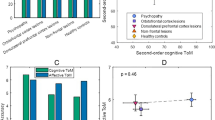Abstract
The states of mind (SOM) model, an information-processing model incorporating positive and negative cognition, postulates five categories that result from the relative balance of positive and negative cognitions. Particular consequences are presumably associated with these differing categories of cognitive balance. In the present study the construct validity of the SOM model was tested by assessing the association between SOM categories and qualitative differences in assertive behavior. Female undergraduates delivered role-play assertive responses to five videotaped situations. Following their last response in each situation, subjects completed a thought-listing protocol. Preliminary analyses showed that responses to the five situations were independent. Contingency table analyses between SOM categories and levels of assertiveness (e.g., refusal vs. qualified refusal) were significant for all five situations. These analyses indicated that a number of the SOM categories were associated with expected qualitative differences in assertive behavior (e.g., internal dialogue of conflict with qualified refusal response). Contrary to Schwartz and Garamoni (1986), the results suggest that positive monologue may not be a dysfunctional cognitive state and show that positive monologue, in contrast to positive dialogue, is more frequently associated with refusal responses.
Similar content being viewed by others
References
Amsel, R., & Fichten, C. S. (1990). Ratio versus frequency scores: Focus of attention and the balance between positive and negative thoughts.Cognitive Therapy and Research, 14 257–277.
Bruch, M. A., Heimberg, R. G., & Hope, D. A. (1991). States of mind model and cognitive change in treated social phobics.Cognitive Therapy and Research, 15 429–441.
Cacioppo, J. T., Glass, C. T., & Merluzzi, T. V. (1979). Self-statements and self-evaluations: A response analysis of heterosocial anxiety.Cognitive Therapy and Research, 3 249–262.
Chiauzzi, E., & Heimberg, R. G. (1986). Legitimacy of requests and social problem solving: A study of assertive and nonassertive subjects.Behavior Modification, 10 3–18.
Galassi, J. P., & Galassi, M. D. (1974). Validity of a measure of assertiveness.Journal of Counseling Psychology, 21 248–250.
Heimberg, R. G., Bruch, M. A., Hope, D. A., & Dombeck, M. (1990). Evaluating the states of mind model: Comparison to an alternative model and effects of method of cognitive assessment.Cognitive Therapy and Research, 14 543–557.
Kaflowitz, N. G. (1986).Testing a self-presentational model of assertive behavior. Unpublished doctoral dissertation, University at Albany, State University of New York.
Leary, M. R. (1983).Understanding social anxiety: Social personality, and clinical perspectives. Beverly Hills, CA: Sage.
McFall, R. M., & Lillesand, D. B. (1971). Behavioral rehearsal with modeling and coaching in assertion training.Journal of Abnormal Psychology, 77 313–323.
Pitcher, S. W., & Meikle, S. (1980). The topography of assertive behavior in positive and negative situations.Behavior Therapy, 11 532–547.
Schwartz, R. M., & Garamoni, G. L. (1986). A structural model of positive and negative states of mind: Asymmetry in the internal dialogue. In P. C. Kendall (Ed.),Advances in cognitive-behavioral research and therapy (Vol. 5, pp. 1–62). New York: Academic Press.
Schwartz, R. M., & Garamoni, G. L. (1989). Cognitive balance and psychopathology: Evaluation of an information processing model of positive and negative states of mind.Clinical Psychology Review, 9 271–294.
Schwartz, R. M., & Gottman, J. M. (1976). Toward a task analysis of assertive behavior.Journal of Consulting and Clinical Psychology, 44 910–920.
Schwartz, R. M., & Michelson, L. (1987). States of Mind Model: Cognitive balance in the treatment of agoraphobia.Journal of Consulting and Clinical Psychology, 55 557–565.
Smith, M. J. (1975).When I say no I feel guilty. New York: Dial.
Author information
Authors and Affiliations
Rights and permissions
About this article
Cite this article
Bruch, M.A., Hamer, R.J. & Kaflowitz-Lindner, N.G. Cognitive balance and assertiveness: Testing the construct validity of the states of mind categories. Cogn Ther Res 16, 653–667 (1992). https://doi.org/10.1007/BF01175405
Issue Date:
DOI: https://doi.org/10.1007/BF01175405




